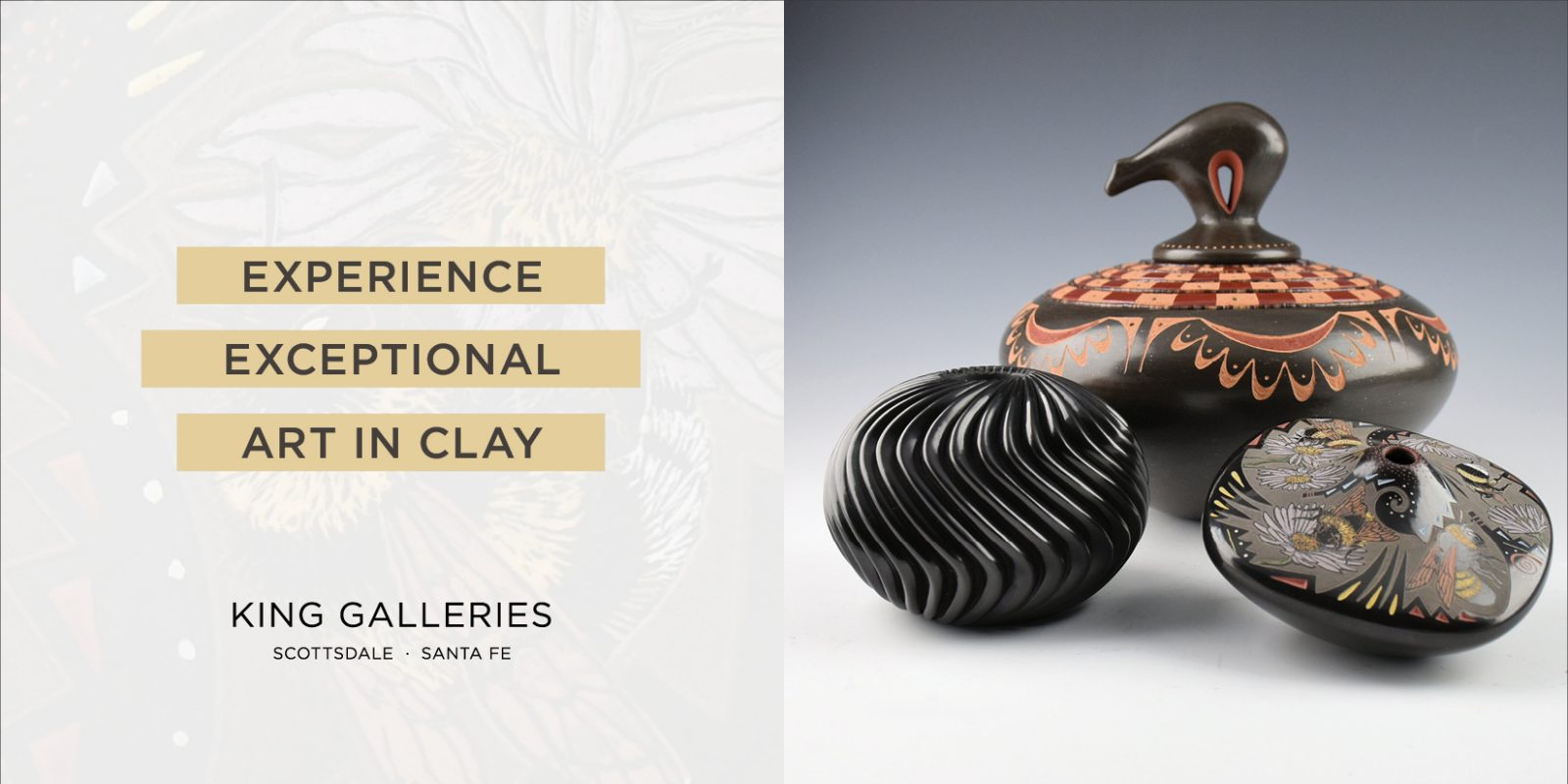Collector's Corner
PROVOCATEUR: The Graphic Art of Kent Monkman
Sometime around 2008 I encountered Kent Monkman’s work for the first time. It took me a few minutes to realize that what I was looking at were more than modern versions of classic paintings. I stared, fascinated by each piece and then came suddenly to the realization of the the provocative aspects of what I was viewing. The paintings were erotic, controversial, even shocking, but certainly not pornographic in spite of the fact that many of the pieces were explicitly sexual. I had seen nothing like this before. A few more years passed before I again saw work by Kent Monkman. By that time, I had decided that I definitely wanted this artist represented in my collection. The rub was that, as a retired high school teacher collecting on a limited budget, his paintings were definitely way beyond my reach. I then thought that I could acquire one of the artist’s drawings. So far, they, too, have been more than I could afford. Then, in 2017 Peters Projects in Santa Fe offered a number of Kent Monkman’s prints for sale. This was the opportunity I had been waiting for and, with the help of Eileen Braziel, I acquired six Monkman works. I generally shy away from controversial artworks, but I feel that the pieces I added to the collection are quite special.
Although he is probably best known as a painter as well as film/video, performance, and installation artist, Kent Monkman has also produced provocative works in the medium of printmaking, a number of which feature his alter ego Miss Chief Eagle Testickle.
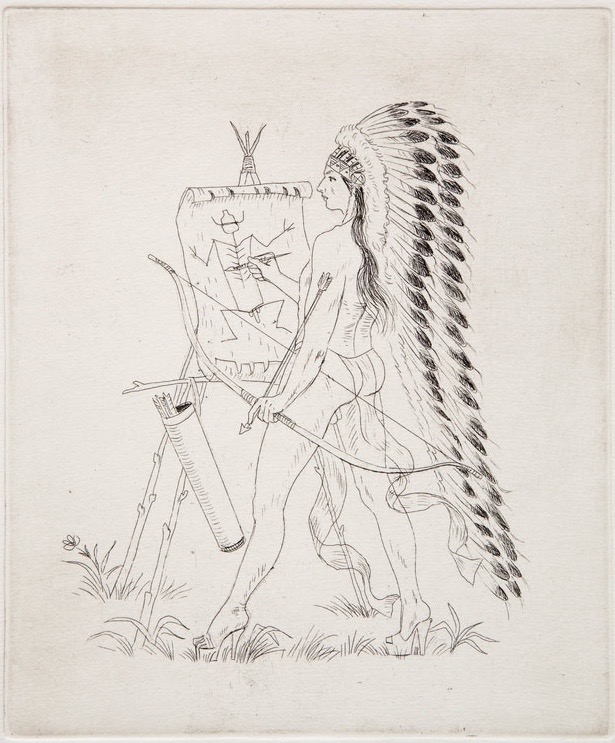
The Artist by Kent Monkman, Cree/Irish, copper plate etching on acid-free paper, ed. 23/100,8.5” x 7” (2016). Collection of E. J. Guarino. (Photo courtesy of Peters Projects, Santa Fe.)
Based on Monkman’s 2003 painting Artist and Model, his print The Artist also features Miss Chief Eagle Testickle. A two-spirit, crossdressing figure, this character is presented wearing a full feathered headdress and holding a bow and arrow, the stereotypical way Native people have often been presented, but she is also wearing an exaggerated loin cloth and high heels. In this version of the colonial story, it is Miss Chief who is in control, recording her version of a frontiersman as a rock on figure drawn on a bark canvas, suggesting that what an artist creates is not necessarily objective reality and certainly not history. Monkmen often uses 19th century works as the basis for his large scale paintings, but infuses the imagery with sexuality. In the 1800s George Catlin created paintings of Native Americans that were touted as faithful representations of the tribes he encountered, but these works have been criticized for their romanticism. Paul Kane, his Canadian counterpart, portrayed the First Nations peoples he encountered in a similar romanticized manner. Albert Bierstadt, another American artist of the period, produced paintings of an American West devoid of humans, thus completely erasing Native Americans from the narrative. As with all artists, the works these men created reflected their own notions and biases about what they saw. From a modern perspective, what these artists often omitted is as important, if not more so, than what they chose to include in their paintings. Kent Monkman’s aim is to bring another voice to the conversation – one that is Native. Miss Chief, his flamboyant creation somewhat modeled after the stereotypical versions of Native garb worn by the performer Cher, is not just meant to shock the view er but to engender thought. Decidedly in the trickster tradition of Native culture, Miss Chief Eagle Testickle allows Mr. Monkman to take control of the narrative by presenting difficult and complex historical and cultural issues through the vehicle of humor. This is indicated by his character’s tongue-in-check name. That it includes the words tickle is certainly not a coincidence, nor is the play on the word mischief. Miss Chief Eagle Testickle makes frequent appearances throughout Monkman’s art.
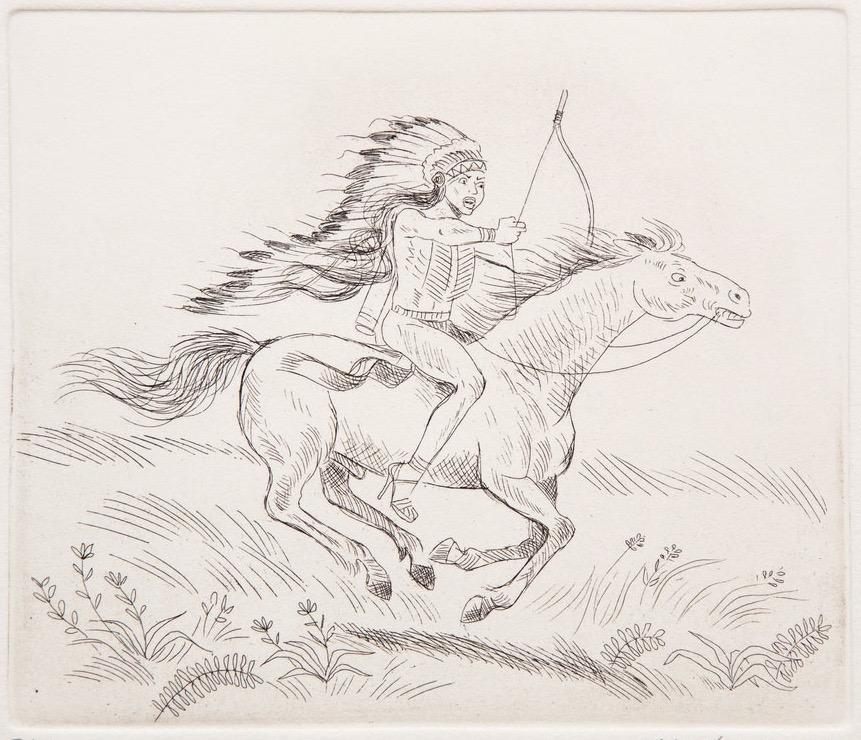
The Hunter by Kent Monkman, Cree/Irish, copper plate etching on acid-free paper, ed. 16/100, 5.5” x 6.5” (2016). Collection of E. J. Guarino. (Photo courtesy of Peters Projects, Santa Fe.)
Throughout the 19th century North America’s indigenous people were romanticized by artists. One persistent image was that of the fierce warrior on horseback, though there were others as well. Such stereotypes lasted well into the 20th century via movies and TV. In The Hunter Kent Monkman deconstructs this cliché through his character Miss Chief Eagle Testickle. Seated astride a galloping course, Miss Chief is bedecked with iconic clothing and objects most closely associated with Native masculinity: a chief’s headdress, breastplate, loin cloth, bow and quiver. Monkman subverts what the viewer expects with the absence of arrows and the addition of high heels, thus raising questions in the mind of his audience regarding gender, history, and culture. The artist is able to tackle such thorny themes in a non-threatening way. By creating an image that appears cartoonish rather than one that is abrasive, the viewer is drawn in rather than put off .
The Treaty of 1869 by Kent Monkman, Cree/Irish, copper plate etching on acid-free paper, ed. 51/100, 4” x 3” (2016). Collection of E. J. Guarino
Note: Because this work is sexually explicit and graphically homoerotic an image has not been included so as not to offend anyone. Those who would like to view this print may do so by going to the following link: http://www.kentmonkman.com/l…/9rbasnphpczp9rn385tjwzjb09qtyi
Because of its explicit sexual nature and the specific act it portrays, The Treaty of 1869 is controversial. The work’s title and imagery are a reimagining of The Treaty of 1868, which is also known as the Treaty of Fort Laramie and the Sioux Treaty of 1868. This treaty was an agreement between the United States Government and the Sioux Nation comprising the Lakota, the Santee, the Yankton, and the Yanktonai. This treaty declared that the Black Hills, which are considered sacred, would be set aside as part of the Great Sioux Reservation. White settlers were not to encroach upon this land, which was the hunting ground of the Sioux Nation. When gold was discovered in the area a few years later, miners illegally moved into he area and conflicts arouse. The miners demanded protection from the U.S. Government, which sent in the army to wage war. Ironically, it was the Sioux whose treaty rights were being violated, not the miners who were not legally entitled to be on Sioux land or anywhere near the sacred Black Hills. In 1876, General George Custer and his troops were annihilated by Sioux and Cheyenne warriors at the Battle of Little Bighorn. The U.S. Government continued to wage war against the the Sioux and in 1877, in clear violation of the 1868 treaty, simply confiscated the Black Hills. To this day the Sioux remain in a legal dispute with the U.S. Government over the ownership of this land. Sadly, the Black Hills are still under environmental siege because of mining and industrial development. In 1889, the Government broke up the Sioux Reservation and forced the inhabitants onto five smaller reservations west of the Mississippi. This was done to make the land available for farming and ranching, though most of these endeavors eventually failed.
Whether or not The Treaty of 1869 is actually referencing and commenting on the Sioux Treaty of 1868 is unclear. It may simply be a generic title alluding to the many treaties made with Indigenous Nations in the 1800s, most of which were violated by the U.S. and Canadian governments. In Monkman’s version of a “treaty,” it is the soldier who is in a submissive position, not the Native warrior. It is the Native who has set the terms of this treaty. Once again, the cartoonish depiction of the two men lessens the work’s shocking aspects.
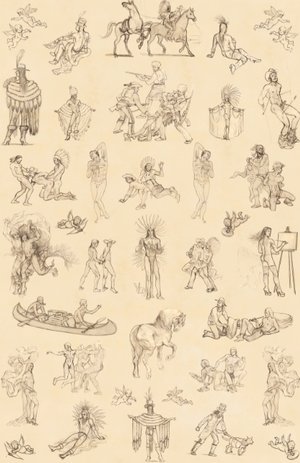
Miss Chief’s Wallflowers [full graphic, full-length), self adhesive vinyl wallpaper by Kent Monkman, Cree/Irish, 144” x 24” (2017). Collection of E. J. Guarino (Photo courtesy of Peters Projects, Santa Fe.)
At first glance, Miss Chief’s Wallflowers appears to portray the usual mundane images of frontiersmen in canoes, on horseback, and interacting with Indians. On closer inspection, much of what is represented is quite the opposite. In addition to the expected activities, a number of the men are engaged in a variety of sexual encounters. Of course, here and there, Miss Chief makes an appearance, wearing assortment of outlandish and incongruous costumes. Although she is glamorous, her insertion into what is usually presented as a masculine and rather nonsexual (except for marriage) environment evokes a comical tone. Miss Chief is certainly no wallflower; she is quite the opposite. The title of the piece suggests the secretive nature of sex during the westward expansion of the United States and Canada during the 1800s. In addition, the artist implies that he sees each image, graphic as it may be, as a flower meant to be seen on a wall, not something pornographic and meant to be hidden away. No one before Kent Monkman has imagined life on the frontier quite this way, certainly not Hollywood nor the artists of the 19th century. Adding to the piece’s humor and mitigating its shock value is the fact that the scenes depicted are on wallpaper that is twelve feet long and two feet wide. Having a room decorated with this material would be, at the very least, quite a conversation piece. As an artist, Kent Monkman is using every means at his disposal to upend traditional views of the colonial history of Canada and the United States.
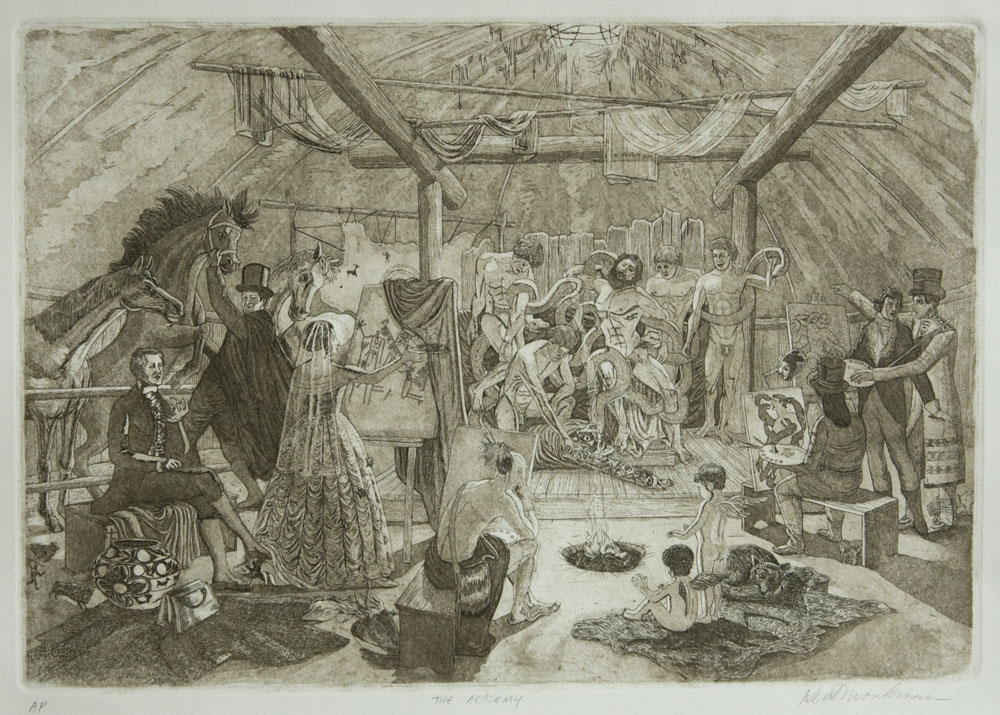
The Academy by Kent Monkman, Cree/Irish, etching and aquatint on paper, ed. 52/75, 13.5” x 19.5” (2011). Collection of E. J. Guarino (Photo courtesy of Peters Projects, Santa Fe.)
Based on Kent Monkman’s 2008 painting of the same name, The Academy is a detailed, complex work that is rich in allusions. The work’s central focus is a group of nude men posed like the ancient sculpture Laocoön and His Sons, which presents the three men in struggling in agony as they are being attacked by serpents. However, in Monkman has added two other nude male models for the onlooking artists to draw: one simply stands in the background while, in the foreground, the other studies a Native carving that looks very much like a miniature totem pole. The setting is a longhouse with a central fire where artists have gathered to paint the grouping of nude men. The Academy presents a mix of Native and non-Native figures. On the right side of the work is a portrait of Indigenous Canadian artist Norval Morrisseau who is painting the the models before him in his celebrated style of painting. To his right, a Euro-Canadian is painting a more traditional image of the models while in discussion with a man dressed in a long coat with Indian-style designs and a top hat.
Gathered around a central fire are two putti standing on and animal skin rug. To their left, is a thoughtful Native painter with an easel who is contemplating the grouping of men before him. To this figure’s left are two important individuals from Canadian history: William Henry Boulton and his wife Harriette. Boulton was a lawyer and prominent politician in the 1800s who was elected mayor of Toronto four times. He and his wife Harriette were painted by the noted portraitist George Théodore Berthon. Today, their portraits are part of the Art Gallery of Ontario’s holdings. In Monkman’s print, Mrs. Boulton, in her wedding dress as she is portrayed in the Berthon painting of her, stands before an easel where she has painted the models before her in the style of Native rock art images. Seated nearby, looking on, is her husband. Both figures look very much as they do in their portraits by George Théodore Berthon. Near Mr. Boulton are a large olla and wooden figures of two buffalo and an Indian.
In The Academy, it is the non-Native models who are objectified and the subject of the artists’ (and by extension) the viewer’s gaze. Monkman makes us consider how Native people were often presented more as exotic curiosities and, in many cases, their clothing and cultures were misrepresented and romanticized. Once again, he has turned the tables on the traditional narrative regarding Native people.
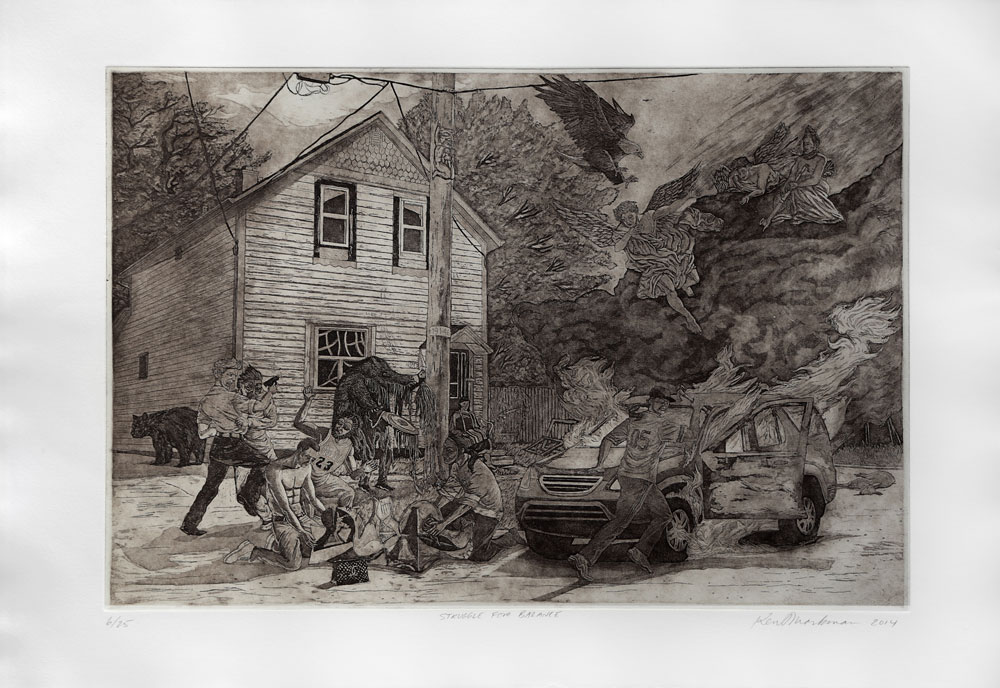
Struggle for Balance by Kent Monkman, Cree/Irish, copper plate etching and aquatint on paper, ed. 19/25, Paper size: 18” x 26;” Image size: 14” x 21” (2014). Collection of E. J. Guarino (Photo courtesy of Peters Projects, Santa Fe.)
An overwhelming sense of chaos and violence is the first impression one gets upon seeing Struggle for Balance. The scene could have been ripped from the nightly news or a newspaper article. Although highly symbolic, it reflects reality. While turmoil swirls below them, two Renaissance-style angels and a Buddhist figure look down helplessly from the heavens as a bald eagle swoops down. Before them is a scene of carnage: a car is ablaze while a man runs away; three men attack or possibly help a female drawn in the style of Picasso; two men struggle over a gun. Bearing witness to these events are a figure in Indigenous regalia, a Native women and her child sitting on the front steps of a nearby house, and a bear who has turned his back on the human havoc playing before him. The print, based on the 2013 painting of the same title, is shocking and disturbing. It presents a portrait of urban decay, in particular colonialism’s effect on Indigenous youth who live in cities away from their traditional cultures.
Kent Monkman’s art is transgressive. It is intended to provoke the viewer into reconsidering long held beliefs about history, society, sex, gender, the Western art canon, colonialism, and Indigenous art and culture. Monkman often takes images from classic European and American paintings and upends them in unexpected ways. Sometimes the artist shocks the viewer; sometimes he uses humor; and at other times he employs a combination of the two to force us to consider what the have been taught from an alternate perspective. It is certainly a revolutionary way of getting the viewer’s attention. The liberal use of nudity and graphic sex has also garnered Monkman attention and controversy. However, the use of such imagery is not gratuitous. No matter how one might feel about Kent Monkman’s output it is thought-provoking and always elicits a response from the viewer. For those wishing to acquire the artist’s work, his prints are an affordable way to begin.
The author would like to express his thanks to Eileen Braziel, of Peters Projects, for her help with acquiring prints by Kent Monkman.
